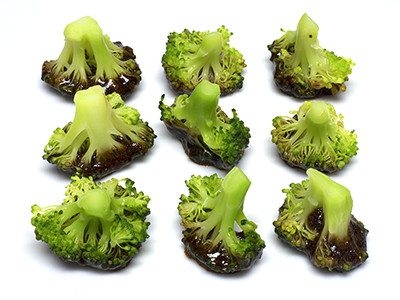August 31, 2015
Amuse-Bouche

brocoli parfumée au sésame huile
(sesame-scented broccoli)
I seriously cooked Chinese-style food for only four years before I headed to the People’s Republic to eat the genuine article. I was part of a group from the US-China People’s Friendship Association in the late spring of 1980. We were one of the first tourist groups to go to Xian. Even before I left, I was keenly aware that what was presented in the United States as Chinese food was not what I would be eating in China. A decade later, when I would be preparing banquets that relied on recipes from books from the PRC, the ROC, and Hong Kong, people asked me stupid questions such as “Do you cook Szechwan food?” I would respond with “Absolutely not! I only cook Palo Alto-style Chinese food!”
I understood that most cuisines really don’t travel all that well. I knew that no matter how many ingredients I used from the PRC, my cooking still would not be authentic. I didn’t care. I had too many Chinese friends who said that I cooked better than their mothers. My goal was good tasting food prepared with Chinese methods and ingredients, not authenticity.
About this same time, I heard about a study that was completed in the New York City Chinatown. The investigators collected statistics on the dishes served at a number of restaurants popular with the non-Chinese community. I would have predicted that sweet and sour pork would have been the most popular dish, but it was only number two. The most popular dish was broccoli beef, and most customers thought they were eating authentic Chinese food. Even today, I chuckle at the irony that the most popular dish consisted of a meat and a vegetable generally not available in China, especially in the early 1980s.
Although broccoli beef was not in my repertoire, there were a number of other broccoli dishes. My favorite was one called broccoli-stem salad. It was a simple: Blanch strips of broccoli stems, and serve with a sauce made of sugar, light soy sauce, and roasted sesame-seed oil. I got the recipe from page 16 of Florence Lin’s Chinese Regional Cooking, a book I purchased in 1975 for $4.50. The dish was always problematic because the sauce would separate and the major flavor, the sesame oil would stay in the bottom of the bowl.
I never used just any sesame oil. It had to be pressed from roasted sesame seeds. It could not just be sesame oil that was colored and flavored to look and taste like the real thing. It had to be the real thing. Today, just like back then, the brand I use is Kadoya.
The elements of this amuse-bouche are now all in place: broccoli, soy sauce, and sesame oil. First issue: How can I mix the oil and soy sauce so it doesn’t separate? Second issue: How can I make the combination stick to the broccoli? The answer to both is aspic! Once again, the eighteenth century comes to the rescue.
I can mix the oil and soy sauce together so they form an unstable emulsion similar to a vinaigrette. If I use a gelling agent, I can stabilize the emulsion. Likewise, if I use the florets of the broccoli instead of the stems, I can use a gelling agent to hold the sauce into the tight spaces between the individual buds in the florets.
20 small
broccoli florets
sauce:
50 ml (3 T + 1 t)
chicken or vegetable stock
1 T
Kadoya sesame oil
1⁄2 t
dark, Chinese soy sauce
0.5 g (rounded 1⁄4 t)
agar powder
1. Blanch the broccoli florets in salted boiling water until almost cooked through. Shock the florets in a water-ice bath. Drain very well on absorbent paper. Chill thoroughly.
2. Mix the stock, oil, and soy sauce in a small saucepan. Sprinkle the agar over the surface. Place the saucepan over high heat. Stir the mixture rapidly, as it heats, to emulsify the oil. When close to boiling, transfer the saucepan to a water-ice bath. Continue to stir rapidly until the mixture cools and starts to thicken slightly.
3. Rapidly dip the buds of each floret into the sauce. As soon as it is dipped, set each piece, buds down, on a flat plate to drain and gel. If the sauce thickens too much, re-liquefy it over the heat.
Yield: The quantities above makes enough sauce for about 20 small florets.
© 2015 Peter Hertzmann. All rights reserved.
